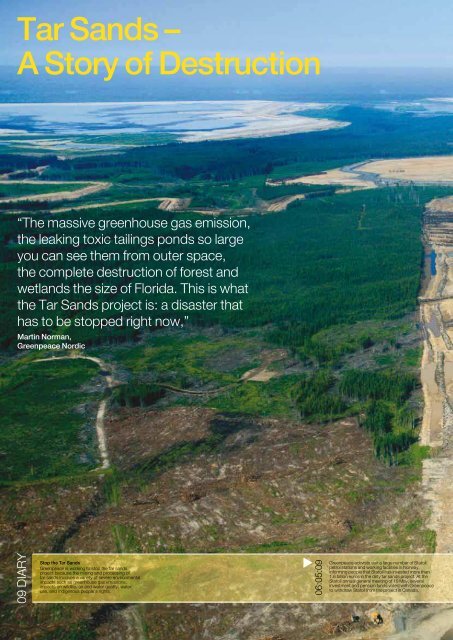Nordic - Greenpeace
Nordic - Greenpeace
Nordic - Greenpeace
You also want an ePaper? Increase the reach of your titles
YUMPU automatically turns print PDFs into web optimized ePapers that Google loves.
Tar Sands –<br />
A Story of Destruction<br />
“The massive greenhouse gas emission,<br />
the leaking toxic tailings ponds so large<br />
you can see them from outer space,<br />
the complete destruction of forest and<br />
wetlands the size of Florida. This is what<br />
the Tar Sands project is: a disaster that<br />
has to be stopped right now,”<br />
Martin Norman,<br />
<strong>Greenpeace</strong> <strong>Nordic</strong><br />
Draped like a green scarf across the<br />
shoulders of North America, the boreal<br />
forest is Canada’s largest ecosystem.<br />
It occupies 35% of the total Canadian<br />
land area and covers northern tundra,<br />
southern grassland and mixed<br />
hardwood trees.<br />
This northern forest, named after<br />
Boreas, the Greek god of the North<br />
Wind, is an interconnected web of life<br />
and plays a significant role in the earth’s<br />
environmental balance. Besides being<br />
a producer of oxygen, the boreal forest<br />
absorbs and stores carbon dioxide and<br />
so plays a critical role in mitigating<br />
global warming.<br />
However, underneath the boreal forest<br />
of northern Alberta, a tale of destruction,<br />
known as the Tar Sands, is being played<br />
out – the largest industrial project in<br />
human history, and probably also the<br />
most destructive, as the extraction<br />
methods used in this area release three to<br />
15 times the CO2 emissions associated<br />
with conventional oil extraction.<br />
Enormous quantities of water are also<br />
used in the process.<br />
The Tar Sands are expected to become<br />
the single biggest growing source of<br />
greenhouse gas emissions in Canada, and<br />
a major driver of the second fastest rate<br />
of deforestation on the planet as forest is<br />
cleared and fragmented to gain access to<br />
the enormous source of oil spread over an<br />
area the size of Florida.<br />
Tar sands are a mixture of sand, clay, and<br />
a very heavy bituminous crude oil which<br />
does not flow. There are currently two<br />
ways to recover the oil from the ground:<br />
to cut down the trees, strip the surface,<br />
dig up the sand and boil it in a machine<br />
to separate the bitumen, or to boil the<br />
bitumen directly out of the ground using<br />
steam and solvents at a temperature of<br />
about 280 degrees Celsius. Because the<br />
bitumen is very low quality, it must be<br />
upgraded to synthetic crude oil and then<br />
refined before it can be used as fuel.<br />
Until recently it was regarded as too<br />
expensive by most oil companies to work<br />
the Tar Sands, but the last years’ increase<br />
in oil prices have prompted explosive<br />
growth in extraction of bitumen.<br />
<strong>Greenpeace</strong> has been working hard for<br />
years to put an end to the destructive Tar<br />
Sands project – a production with severe<br />
global consequences, as government<br />
revenue from the tar sands and oil<br />
industry lobbying have made Canada<br />
a regular global carbon bully, fighting<br />
standards to lower the carbon content<br />
of fuels, lobbying against U.S. legislation<br />
to lower emissions, muzzling federal<br />
scientists, and obstructing international<br />
climate change negotiations.<br />
Apart from the Canadian Government,<br />
owners of oil companies from all over the<br />
globe, such as the Norwegian state owned<br />
oil company Statoil, are responsible<br />
for this boundless destruction. In 2009,<br />
<strong>Greenpeace</strong> therefore confronted owners<br />
of Statoil throughout the world and asked<br />
them to instruct the company to pull out of<br />
the Tar Sands.<br />
Several actions against Shell, Statoil,<br />
Suncor, BP and Total generated massive<br />
attention from media, politicians,<br />
investors and governments, and in<br />
the <strong>Nordic</strong> countries, <strong>Greenpeace</strong><br />
managed to convince prominent Statoil<br />
shareholders KPA, Folksam, Storebrand,<br />
7:e AP Fonden and SPP to vote for a<br />
<strong>Greenpeace</strong> proposal at the Statoil annual<br />
general meeting of 19 May 2009 to pull the<br />
company out of the Canadian madness.<br />
The Swedish church did not vote for our<br />
proposal, but it subsequently sold all its<br />
shares in Statoil.<br />
Major steps forward were taken in 2009,<br />
but more will follow as <strong>Greenpeace</strong><br />
continues the fight in 2010 in the <strong>Nordic</strong><br />
countries and globally to stop the Tar<br />
Sands project.<br />
Image: Tar Sands, Canada<br />
Aerial view of clearcuts at a tar sands mining operation<br />
north of Fort McMurray, northern Alberta, Canada<br />
©<strong>Greenpeace</strong>/Jiri REzac<br />
09 DIARY<br />
Stop the Tar Sands<br />
<strong>Greenpeace</strong> is working to stop the tar sands<br />
project because the mining and processing of<br />
tar sands involves a variety of severe environmental<br />
impacts such as greenhouse gas emissions,<br />
impacts on wildlife, air and water quality, water<br />
use, and indigenous people’s rights.<br />
06:05:09<br />
<strong>Greenpeace</strong> activists visit a large number of Statoil<br />
petrol stations and working facilities in Norway,<br />
informing people that Statoil has invested more than<br />
1.6 billion euros in the dirty tar sands project. At the<br />
Statoil annual general meeting of 19 May, several<br />
investment and pension funds voted with <strong>Greenpeace</strong><br />
to withdraw Statoil from the project in Canada.<br />
30:09:09<br />
In the heart of the tar sands,<br />
north of Fort McMurray,<br />
<strong>Greenpeace</strong> activists stop<br />
two bitumen conveyor belts<br />
to highlight the environmental<br />
crime and stop Suncor’s<br />
operations.<br />
08:10:09<br />
<strong>Greenpeace</strong> activists<br />
display giant banners<br />
at the French company<br />
Total’s refinery site in<br />
Gonfreville-l’Orcher,<br />
located close to Le Havre<br />
(Normandy).<br />
<strong>Greenpeace</strong> <strong>Nordic</strong> 2009 15

















